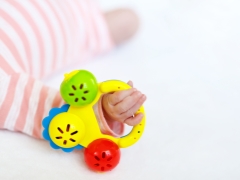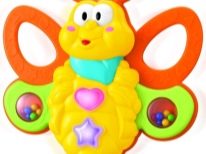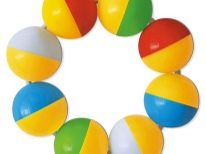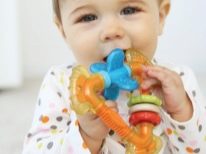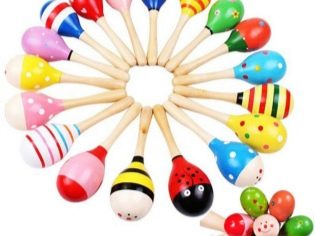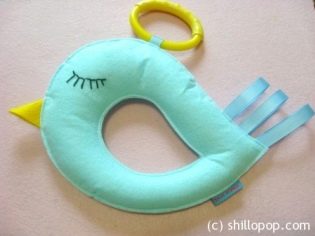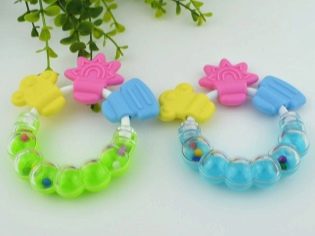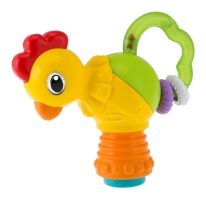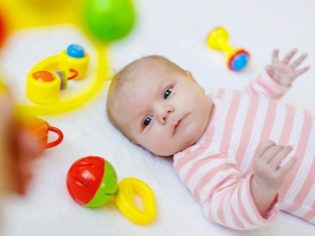What are the rattles and which model to choose for a newborn?
Rattles are perhaps the most invariable attribute of any baby. With their help, the baby learns the laws of the surrounding world, in particular, learns that the mechanical effect on many objects allows you to create a particular sound.
As a rule, baby rattles are made in the form of some kind of toy. However, choosing them correctly is not as easy as it might seem at first glance.
A bit of history
The rattle was not invented yesterday, but no one can say with accuracy when people first guessed to make such toys for children. The fact is that at first such an object played a completely different role, which was in no way connected with the upbringing of children.
It is known that rattles were used in ancient Greece during religious rites. This use of them is documented, but we can safely assume that similar devices were used by different prehistoric tribes in all corners of the globe.
According to Russian traditions, a rattle is often perceived as a musical instrument that could be used as a supplement to the drum or mounted on festive costumes or horse harness. In the culture of many small nations of Russia, the rattle is still used as an accompaniment for dancing or religious rituals. Initially, the rattle was not only entertaining, but also symbolic, protecting the child from evil spirits.
Benefit and harm
Baby rattles play a key role in the early development of the baby. Having been born, he still does not know how to use even the senses he has. Therefore, a rattle for newborns can become its first simulator. There are a number of advantages of acquiring such a gift.
- Listening to the sound of the rattles and examining it, the child begins to catch a pattern between where the noisy object is and its location. Thanks to the rattles, we adults understand where the sound is coming from.
- At first, the newborn is not able to focus for a long time even on a static object, but the rattle, making a noise, attracts the attention of the baby. If the parents move it, the child learns to follow moving objects, increasing their own concentration of attention.
- In the future, the child will be able to hold small objects in his hands, and the rattle will be one of the first. Holding it in inept hands, the baby develops finger motor skills, thanks to which his grip becomes more confident and stronger.
Harm from a good rattle should not be, the only exception will be except that very loud species that can scare the child or interfere with his parents sleep.
From what age is it worth buying?
Virtually all types of toys are labeled with an indication of the minimum age at which they should be used. Although rattles are the simplest kind of toys, yet they can not always be used literally from birth.
It should be noted that It’s really worthwhile to train the attention and well-coordinated work of the sense organs from birth, but not any rattle is suitable for such purposes. The newborn does not own his limbs at all to hold such an object in his hands.He cannot even turn aside if the subject is out of the field. of view.
That is why for the smallest it is recommended to choose hanging type rattles, which are always in sight.
Starting from three months, the use of rattles really resembling toys is considered acceptable. The child is not yet able to lift such objects, but he can already independently bring them into action if they are in the zone of the nearest availability. Gifts of this type also improve the child's tactile skills, because to get the sound he will have to touch the subject.
After reaching the semiannual age, you can use the most complex rattles, for example, those that are attached to the dining table. This solution allows the child to play and develop even during the meal, but the sucker does not allow you to reset the toy. A teether with a rattle function will also be a good option.
When does the baby start to react to the rattle?
The use of rattles brings benefit to the baby literally from birth, but the fact that he perceives the toy and reacts to it becomes not immediately obvious. This is caused not only by a weak level of development of the nervous system, but also by the actual inability of the infant to demonstrate its reaction.
However, scientists proved that already from the fourth week of life, the baby is able to approximately determine the direction of the sound, trying to turn his head and look in that direction.
When does it start to hold?
In the first months of life, the baby is already interested in rattles, but he still lacks the strength and ability to hold such a toy in his hands. No wonder toys of manual type are not recommended for use earlier than three months of age. It is at this stage that the child finally reaches the level where he can already touch nearby objects on his own will.
The question of exactly when he will begin to hold the object in his hands, depends on the individual characteristics of the development of each child. Wherein from 7 months we recommend the use of suckers rattles, because at this stage the child is already able to deliberately push objects from horizontal surfaces. As a rule, now the baby is already capable of holding small rattles in his hands.
Models and types
Although the rattle seems to be an extremely simple design, manufacturers have come up with at least a dozen of its varieties. They differ not only in appearance, but also in the age of their target audience.
For newborns, they usually buy those rattles that are hung on strollers, cribs and car seats. This is convenient since in the first months of life a child can only look upwards, and it is there that the developing object is fixed. During a trip by car or light motion sickness, the baby hears the sound of such suspensions and stretch marks.
An alternative for the smallest can be a bracelet, worn on the arms or legs. Another thing is that for the full use of such a gift is needed and a fairly well developed physical activity, and the possibility of a good overview of the source of the emitted sound.
When using bracelets, parents must make sure that the bindings do not pinch their baby’s limb.
In addition, there is a huge variety of other types of rattles, which are designed for children from 3 months and older.
- Starting from 3 months, the child slowly begins to be interested in surrounding objects, trying to reach them. Rattle attracts increased attention, because it can be an excellent grasping reflexes simulator. In this situation, perfect mace or maracas, and special legs are bought for the legs cute socks with noise function. A nice gift will also be light knitted amigurumi toys with bells.
- After three months, you can give the baby rattles with other useful properties.For example, it is during this period that the baby’s teeth begin to erupt, causing him discomfort. You can search in children's stores teetherscapable of making noise when shaken. In addition, at this stage, the child increasingly leaves the crib and can even play on the floor, so that rug rattle he also does not hurt. At the same time, he will help the mother to hear whether the child has crawled off to the side.
- A few months later, you can gradually begin to buy developing rattles, in which the noise function is perhaps just an extra. These include various puzzles and books. Do not worry that the child is still infinitely far from being able to read on their own. If the book has beautiful pictures, and even it can make noise, the stable interest of the young "reader" will be guaranteed.
In addition, in the shops you can find and personalized rattles, which is especially important in the case when several babies grow up in the same family.
Types of materials
It is no secret that many types of material are considered unsuitable for children for a number of reasons. Today, rattles usually come from four different materials, each of which has its own characteristics.
- Plastic toys for kids the most popular among the manufacturers themselves, because this material is inexpensive, but it allows not to limit the imagination of designers. High-quality plastic samples are completely safe and different bright colors. In addition, this rattle is very convenient to wash, because it does not absorb pollution.
In this case, the choice should be taken more carefully, because many consumers choose such a product for a low price, which often indicates low-quality and toxic raw materials.
- Wooden rattles in fashion longer than any other - a few centuries ago, their predecessors were also made of birch bark and wood. The tree is completely safe for the child, its production does not pollute the environment, while the surface of the product is also pleasant to the touch. But rattles made of wood are quite large for the hands of the baby weight, and even traumatic - they can hurt.
- Textile and knitted soft rattles they look very attractive, are weightless and cannot be injured. Their appearance is so elegant that one of the varieties of such toys, amigurumi, is rapidly gaining popularity even among adults. Such dolls are even used for indoor decoration.
- Toys made of felt provide the child with pleasant tactile sensations, stimulating additional interest in the subject. The price of such products is also relatively low, but there is one drawback: the fabric easily absorbs dirt, so it will have to be washed with unenviable regularity.
- Silicone rattles It is more correct to call teethers, since the latter are made only from this material. The main advantage of the choice in favor of silicone is the ability to combine the functions of two objects at once. At the same time inside the teether there is usually a liquid that alleviates the suffering of the baby from teething, so you should carefully monitor the integrity of the product.
Popular brands
Many parents have no time or desire to understand all the subtleties of the choice of rattles. Therefore, they prefer to make their choice in favor of well-known brands that produce time-tested products.
In terms of quality, it is most advisable to select products from Western manufacturers. These include, for example, Italian rattles. Chicco or israeli Tiny Love. Delivery from a distance may adversely affect the cost of the product, but there is no doubt about its quality.
Russian consumers have naturally high demand for products from domestic producers, since it is most affordable both in price and in proximity to the buyer. Russian brands include Stellar and the "World of Childhood". Reviews of similar products come across polar: from delight and admiration to a complete misunderstanding of how to buy such a second time.
Not to mention Chinese goods, they are increasingly seizing the global market, and rattles are no exception. At the price of such a purchase will cost even cheaper than the Russian counterpart, but it is impossible to single out at least some one manufacturer here, they are too uniform models.
Tips for choosing
Products for children need to choose very carefully, because the kids are all pulling in the mouth, and their health is not yet ready to resist various troubles. For this reason, it is important to explore some more tips on how not to buy a potential threat to your child instead of a developing toy.
- The quality requirements for rattles are so high that such products can even be specifically certified. For this reason, do not recommend to buy rattles in the markets. It is necessary to trust only large children's stores and pharmacies.
- Unpleasant smell emanating from the product, is one hundred percent reason not to buy it. As a rule, it indicates the use of low-quality raw materials or dye.
- Perfect surface smoothness is a must for rattles. Each chip or sharp angle can cause injury to your baby.
- Children like everything bright, but in nature there are practically no safe dyes of “poisonous” shades. In addition, it is better to train the visual apparatus on natural colors.
- Before you buy, be sure to evaluate the sound made by the toy. The noise should be pleasant and in no case not harsh, otherwise there is a risk of frightening the baby. Then he will not be interested in a rattle.
- Scientists have found that infants are not able to lift an object weighing more than one hundred grams. Consequently, the rattle should weigh less, otherwise it will not contribute to the development of fine motor skills.
- When choosing a teether, you must ensure the integrity of the product, otherwise liquid filler may leak. Then the purchase will turn into a shapeless and useless silicone case.
- For more variety, you can buy a baby a whole set of rattles, but it should be understood that he does not need too much. In the first months of life, even one toy can “load” its small brain for 5 minutes a day. At an older age, he will already need more diverse entertainment.
How to play?
In the first months of life, it is necessary to play with rattles with a child quite carefully, since he, guided by his reflexes, can grasp the product and swallow him or his part solely out of his own curiosity. Such reflexes work already in the first month of life, but they are completely unconscious, so it can not even be called a game.
They play with the newborn, gently swaying the rattle at a distance of 25-30 cm from his face. Such a game should not last more than 2 minutes, because the child is still not able to focus on a longer period.
From about two months you can put rattles in your child's hand so that he learns to hold them consciously. From the first time, this is unlikely to succeed, but with the proper amount of exercises already at three months, the baby will be able to take the toy from her mother's hands, consciously examine it, and even purposefully rattle.
How to choose the right rattles for the little ones, see the next video.
